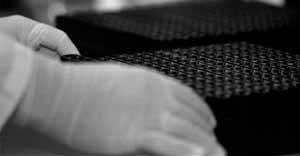Biotechnology Center fostering learning at USU
Providing hands-on experience for students and faculty is what Utah State University’s Biotechnology Center is all about.
Nestled among the Biology and Natural Resources Building, Natural Resources Building, Agricultural Science Building, Science and Technology Library and Computer Center Building, the center, built in 1986, houses resources to do a variety of projects, said Kamal Rashid, acting executive director of the center.
“We have a full basement where we can perform fermenting, protein purification and mass spectrometry,” Rashid said.
According to the center’s fact sheet and history, the center supports research in agriculture, food processing and safety, animal genetics, the environment and other aspects of biotechnology research.
Several 5,000-level courses are taught in the center, Rashid said. The center provides laboratories, technicians, materials, supplies and faculty to assist in research, he said.
Rashid, who is in his second year at USU after working 18 years at Penn State, oversees the day-to-day activities of the center and teaches a course called methods in biotechnology.
“Very few universities have programs like this,” Rashid said.
He said the emphasis on hands-on experience students receive is very beneficial for them, especially when they have aspirations in biotechnology.
“We don’t have a department of biotechnology yet,” Rashid said. “At Penn State, we placed students in high-paying jobs. There is a lot of demand in areas of biotechnology.”
Rashid said he wants to see if the biology; chemistry; animal, dairy and veterinary science; nutrition and food science; and plants, soils and biometeorology department heads can add a specialization of biotechnology to their already-offered majors.
Biotechnology is already being taught at Utah high schools, Rashid said. Among the examples he shared were Weber and Murray High Schools. Rashid said approximately 120 students at Murray High School are studying biotechnology, and Rashid projects that number to grow.
“The state of Utah will [begin] emphasizing biotechnology,” he said. “We’re here to offer them help.”
The center has helped foster the growth of biotechnology in two ways, Rashid said.
First, USU offers a biotechnology summer academy for Utah high school students in which each participating student completes a five-day internship in a biotechnology-related project of his or her choice, according to the academy’s brochure. Students work with several of the more than 50 faculty members currently involved in biotechnology-related research at USU, Rashid said.
“This helps us attract high-caliber students,” he said.
Second, in October, USU held an annual biotechnology symposium for science teachers in which participants heard from fellow science teachers about ways to incorporate biotechnology into existing science courses, as well as discussions on bio-ethical issues and presentations of potential career opportunities for graduates with biotechnology laboratory experience, according to the symposium’s schedule.
Rashid said he wants USU students to be in the forefront of the biotechnology revolution.
“I’m going to work hard to make sure students benefit,” Rashid said. “We’re student-oriented. That’s why I’m here.”

Researchers in the Biotechnology Center use tools such as a gamma counter in immune studies along with the radioactive isotope Cytoxic T-cell Assay. (Zak Larsen )

